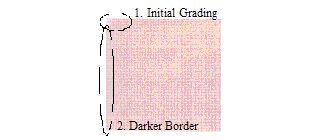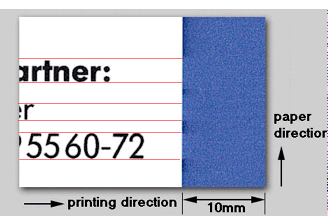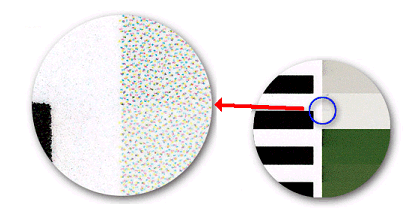 |
Enrichment Issue |
| |
|
Issues Description
There can be some light color area fills that have two different
(but related) image quality issues at the border:
|
| |
 |
1. The initial
part of the area fill has a grading from white to the regular color
of the area fill
(~ 2-4mm high x 0-10mm long)
2. After this first grading, it may show a border
darker than the rest of the area fill, creating another type of
grading, which is shorter, but can appear along the entire border. |
| |
See the following image to better
understand the explanation:

As it will be explained, both issues are related and
have similarities:
|
| |
| |
-The appearance of the issue depends highly on
the selected printmode (MaxQuality, Productivity or MaxSpeed) and
the medium and ink type loaded into the printer.
-The darker border issue may show along the entire border, or appear
in some determined locations and disappear in others.
-The direction of this grading is always in the printing direction.
-This problem shows up much more in composite light colors and unidirectional
printmodes (when the printer lays ink only when the carriage moves
in one direction). |
| |
See the following image:

|
| |
 |
 |
|
Cause:
Before going to the root cause, we have to understand two main
concepts of the inkjet technology:
|
| |
 |
1. The dye ink is
made by a liquid and pigments (which, in fact, delivers the color
to the ink).
2. This ink is contained on the
printhead nozzles.
3. An internal heating process
eject the drops of ink that are delivered though these nozzles. |
| |
Therefore, during the normal printing
process, the printer is firing the drops of ink over the media by
heating the ink that is contained on the nozzles.

The cause of the issues is that, when the nozzles are on the resting
state for some time, the liquid of the ink evaporates. We have two
different cases:
|
| |
| |
1. If the resting state is
not very long, the water of the ink only evaporates partially, which
leaves the ink on the nozzle with more pigments. Therefore, the
initial drops ejected from those nozzles will be darker (they have
more pigment) than the following ones. This leads to the second
issue (darker border). If we take the previous example, we will
observe that the parts of the border which are darker corresponds
to the parts which have not printed for some time.

If we magnify the error you will see that the darker
part (which is not printing) has darker drops, because of the initial
excess of pigments.

2. If the resting state is maintained longer,
the water of the ink evaporates almost completely, which blocks
the nozzle from a small amount of time while it is refilled with
fresh ink. |
| |
 |
 |
|
Workarounds
This image quality problem is a product limitation. So, it has
NO solution. Anyway, due to the limited cases where the problem
could appear, large amounts of complaints are not expected.
If any customer complains about this problem, provide the following
workarounds:
|
| |
 |
-Rotate the image. Remember that this
problem only appears on the scan-axis direction when there are light
colors are fills in the borders. By rotating the image, you may avoid
this type of colors in the scan-axis direction.
-If using a RIP, print in bi-directional print-mode.
-Circle the print with a black frame that will stabilize the printheads
before doing the print. |
| |
